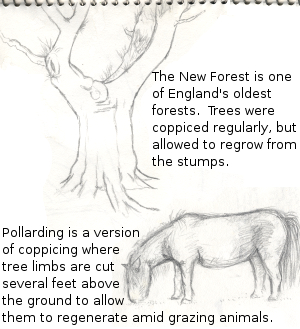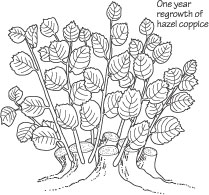
Coppicing in the southern Appalachians
 I've
been intrigued by coppicing ever since I visited the ancient New Forest
in England and saw huge trees that had been providing wood to the
locals for hundreds of years. The idea is simple --- certain
trees resprout when they're cut, so you can cut off the shoots every
five, ten, or twenty years and have a renewable source of wood without
disturbing the forest. Since I'd only read about coppicing in
Europe, I was excited to hear Zev Friedman's information on which
species can be coppiced in our neck of the woods.
I've
been intrigued by coppicing ever since I visited the ancient New Forest
in England and saw huge trees that had been providing wood to the
locals for hundreds of years. The idea is simple --- certain
trees resprout when they're cut, so you can cut off the shoots every
five, ten, or twenty years and have a renewable source of wood without
disturbing the forest. Since I'd only read about coppicing in
Europe, I was excited to hear Zev Friedman's information on which
species can be coppiced in our neck of the woods.
The eight species that
Zev considers worth coppicing in the southern Appalachians are black
locust, mulberry, willow, basswood, tulip-tree, hazelnut, black cherry,
and chestnut. These trees not only resprout copiously, the bushy
habit you get after coppicing has a benefit to the forest
gardener. For example, mulberries bear fruits on first year wood,
so the fruiting area tends to move further and further out on the
tree. By coppicing, you keep the mulberries within reach, and can
even coppice part of the tree each year so that you have young wood
ready to bear fruit annually.
 On the backyard scale, you're
probably only going to have a few trees to coppice, but on the
homestead scale you might set up an entire woodlot in what's known as
"coppice with standards." Standards are full-sized trees that are
left alone and only cut every 75 to 150 years for timber, providing
shade and livestock feed in the interim. Oaks are a good choice
for standards in our area (or perhaps walnuts or sycamores in damper
areas?), and Zev recommends keeping 20 standards per acre.
On the backyard scale, you're
probably only going to have a few trees to coppice, but on the
homestead scale you might set up an entire woodlot in what's known as
"coppice with standards." Standards are full-sized trees that are
left alone and only cut every 75 to 150 years for timber, providing
shade and livestock feed in the interim. Oaks are a good choice
for standards in our area (or perhaps walnuts or sycamores in damper
areas?), and Zev recommends keeping 20 standards per acre.
Scattered amid the
standards are the smaller trees that are coppiced much more
regularly. These coppiced trees are generally spaced 6 to 10 feet
across on diagonal and provide firewood, fiber (mulberries), tender
young leaves (basswood), mushroom logs (tulip-trees for oysters and
oaks for shiitakes), and fruits or nuts. We might try coppicing
our mulberry tree and hazelnut bushes in a couple of years to see what
kind of growth form results.
| This post is part of our Real Forest Gardening lunchtime series.
Read all of the entries: |
Want more in-depth information? Browse through our books.
Or explore more posts by date or by subject.
About us: Anna Hess and Mark Hamilton spent over a decade living self-sufficiently in the mountains of Virginia before moving north to start over from scratch in the foothills of Ohio. They've experimented with permaculture, no-till gardening, trailersteading, home-based microbusinesses and much more, writing about their adventures in both blogs and books.
Want to be notified when new comments are posted on this page? Click on the RSS button after you add a comment to subscribe to the comment feed, or simply check the box beside "email replies to me" while writing your comment.

http://www.kickstarter.com/projects/coppiceagroforestry/dave-and-mark-write-a-coppice-agroforestry-book
===I have been getting the emails on this one....it is going to be very good indeed.